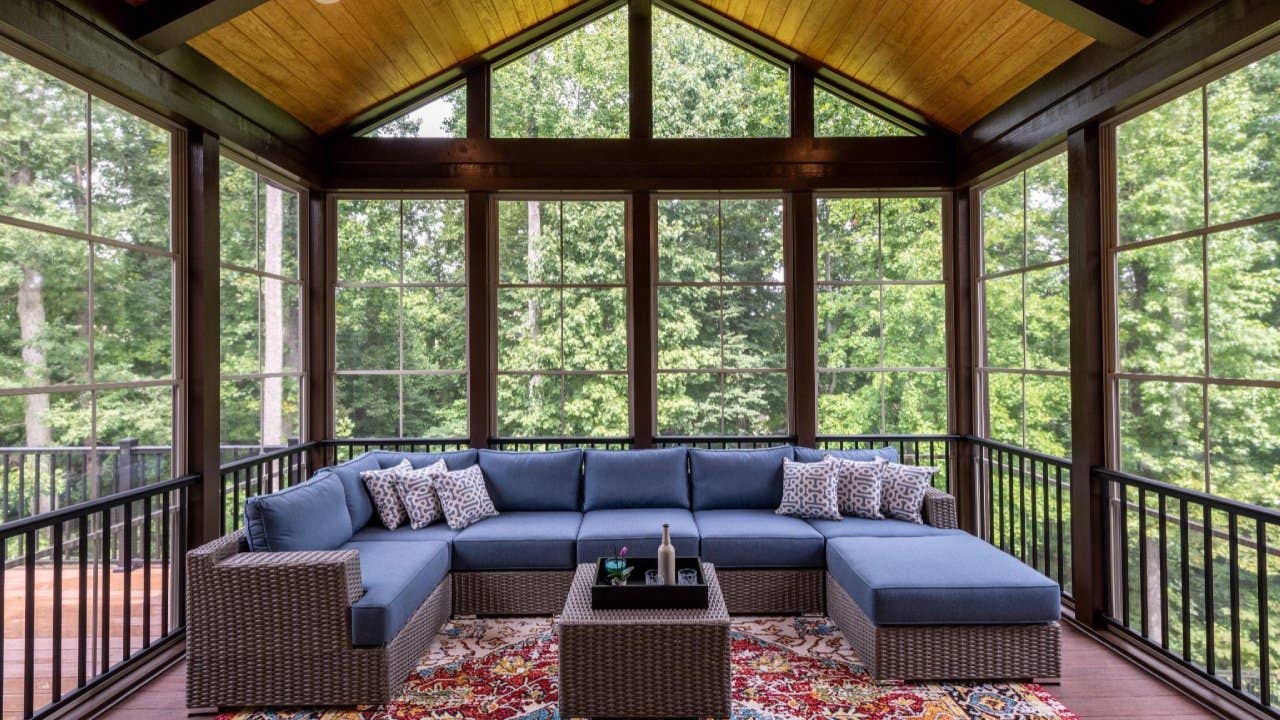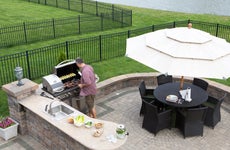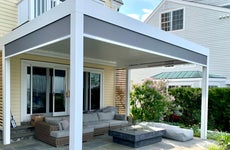What does it cost to enclose a porch?

The Bankrate promise
At Bankrate we strive to help you make smarter financial decisions. While we adhere to strict , this post may contain references to products from our partners. Here's an explanation for .
Ah, the good ol’ summer porch. It’s not just for summer anymore. But upgrading your porch to make it suitable for all seasons (or even just some seasons) comes with a cost.
Simply screening in an existing porch could cost as little as $600 or as much as $3,500, with the national average being $1,200 (about $4.50 per square foot), according to HomeGuide, the online contract-search service. Fancier types of enclosures — ones that make the porch usable year-round — can run much higher though: from $8,000 to $45,000, with the national average being $13,200 (about $70 per square foot). Your choices in materials, styles and size will also impact the final price tag for the project.
Basically, the more often you want to use your porch — the more like a regular room you want it to be — the more the enclosure costs. But porch upgrades, which took off during the stay-at-home pandemic years, remain a popular project — part of the trend towards expanding and enhancing the living space of the home. In fact, 12 percent of renovating homeowners opted for a porch addition or upgrade in 2022, according to the “2023 U.S. Houzz & Home Study.”
Key takeaways
- Enclosing a porch can range on average from $1,000 to $13,000, depending on how much like a regular room you want it to be.
- There are three types of enclosed porches: year-round (aka sunroom), three-season and screened-in.
- Materials followed by labor are the most costly components in enclosing a porch, along with the need for a new foundation/roof, to clear land or to install wiring or plumbing.
Types of enclosed porches
Enclosed porches come in three basic varieties. Here’s a look at average costs and porch features, according to HomeGuide data.
- Screened-in: $600 to $3,500
- Three-season: $8,000 to $60,000
- Four-season: $20,000 to $80,000
Screened-in
This is the most plain-vanilla, relatively quick and inexpensive approach to enclosing your porch: just adding screens to the sides. Screening in your porch will protect the area from critters and bugs, and keep the rain out. On the downside, there’s no climate control, so it won’t extend the seasonality of the porch that much.
3-season (windowed or walled-in)
With this style, your porch is walled or windowed to protect it from the elements, and it also improves temperature regulation: The closed windows can trap heat in, or on warmer days, they can be opened to allow a breeze into the porch. However, because these porches aren’t insulated, they won’t be usable in the dead of winter, and they could be cold on nippier days.
4-season (insulated, incorporates HVAC)
A fully insulated porch takes the advantages of the others and adds the benefit of climate control: You can connect your porch to your home’s HVAC system and fully regulate the temperature. These porches have insulation in the walls, and preferably insulate the windows as well. In short, the porch becomes like a regular room. The downside of four-season porches is that they cost more, have a more complex build process, and take longer to build than the alternatives.
What are the cost factors for enclosing a porch?
Location
As with any job, materials and labor will vary in price, and your location and the availability of contractors in your area can influence prices too. Certain cities and towns may also require that you apply for permits to complete your porch project, depending on how extensive it is. Permits generally run a few hundred dollars.
Then there’s your particular property lot. If the project is extensive, it will increase your costs even further — especially if you need to have trees removed or to level out your yard.
Pre-existing foundation/roofing
If you don’t have a pre-existing foundation or roof, it will also mean added expenses. Fixr.com estimates the expense of installing a foundation for a new four-season porch will account for about 8 percent of your total project costs. Roofing costs account for about 12 percent of total project costs, ranging from $2,500 to $8,000 on average.
Labor
Depending on your project, you may need to hire a general contractor to help with your porch enclosure. If this is the case, you’ll need to account for labor costs.
Labor represents a significant portion of the cost to enclose a porch, although less than materials in many cases. The style and size of the porch have a strong impact on the amount of labor required, but you can expect labor generally to make up 20 to 40 percent of the total cost. Homeowners should expect to spend $4,000 to $20,000 on labor, depending on the project.
Materials
Materials have a wide cost range depending on the purpose and type.
- Screened-in porch: Materials cost $600 to $3,200, according to HomeGuide. We’re talking mainly about the screen mesh here, which varies significantly by price per square foot — from fiberglass (15 cents) to copper ($6.50). Other popular materials include vinyl-coated polyester mesh (58 cents), bronze (85 cents) and stainless steel ($1).
- Three-season: $5,000 to $30,000, according to HomeAdvisor. Materials for a three-season room enclosure can vary, but generally include framing materials and windows, at a minimum. Windows can run from $200 at the lower tier, up to over $2,000 at the high end. Lumber costs for framing vary, but generally will be only a small portion compared to the windows.
- Four-season: $15,000 to $60,000, according to HomeAdvisor. Four-season rooms include all of the material costs of a three-season, but with extra materials required. These enclosures utilize insulation in the walls, and may tend towards higher-priced insulated windows. Wall insulation costs range from 20 cents to $2 per square foot depending on the material used and how thick it is. Common options include fiberglass batting (30 cents to $1.50), spray foam (50 cents to $2), and rigid cell foam (25 cents to $2).
Electric wiring
If you’re incorporating light fixtures into your space, you can expect the necessary wiring to cost up to $600 alone, according to HomeGuide. This doesn’t include the cost of installing light fixtures, outlets, or switches, which can cost up to $415, $275, and $250, respectively.
Enclosed porch vs sunroom: What’s the difference?
It’s a bit confusing. Both three- and four-season porches are commonly referred to as sunrooms.
Usually, sunrooms are akin to the four-season variety of enclosed porch. Both typically have windows, insulation and HVAC systems, making them usable no matter the season. But you can have a more modest sunroom that’s uninsulated, like a three-season porch — just with plenty of windows.
So you could say all sunrooms are enclosed porches, but not all enclosed porches are sunrooms — the plain-vanilla, screened-in variety wouldn’t qualify. And there are other nuanced differences. Some insist that, by its name and nature, “sunroom” implies a regular room, albeit one that focuses on the outdoors, suitable for year-round occupancy (three-season won’t do). Others say a space is a sunroom if it’s under the same roof as the rest of the house, not an extension or overhang (like a porch). And in some parts of the country, a porch is always elevated to some degree, whereas a sunroom can be at ground level.
Cheap ways to enclose a porch
Some aspects of an enclosed porch can be achieved without much expenditure or labor. Hanging curtains, putting up hedges or installing some lattice work on the sides can help create privacy and aesthetics without breaking the bank. These upgrades may not keep out weather and bugs, but they can still make a significant difference in how a porch looks and feels.
How to fund enclosing a porch
Personal loan
Banks, credit unions, and online lenders may offer personal loans, which you can use to offset the cost of your porch project. The amount you can borrow will differ by lender, but many offer personal loans of up to $35,000 or $50,000. You’ll typically need good to excellent credit to qualify for a personal loan with most lenders.
Personal loans typically have fixed interest rates that are often higher than what you’d get with home equity loans or home equity lines of credit (HELOCs). But because you aren’t borrowing against your home equity, a personal loan can be a simpler and quicker option. Loan funds are often disbursed within a couple of days.
Home equity loan
A home equity loan is another option for funding your porch project, assuming you have a sufficiently large ownership stake built up. Generally, you’ll need around 15 to 20 percent equity to qualify for this sort of financing, and your home serves as collateral for the loan. It typically takes around two to six weeks to get a home equity loan, so keep this timeframe in mind if your project will be starting soon.
With a home equity loan, you borrow a lump-sum amount and generally benefit from a fairly low interest rate and terms as long as 30 years. Home equity loans typically have fixed rates and borrowers often need a reasonable debt-to-income ratio — often under 43 percent — and fair or good credit to qualify.
Home equity line of credit (HELOC)
A HELOC is another option if you have sufficient home equity. As with a home equity loan, you’ll need a reasonable DTI and fair or good credit to qualify for a HELOC, and it can take two to six weeks to get this type of credit line. HELOCs also typically come with relatively low rates.
But unlike home equity loans, HELOCs generally have variable rates, which can fluctuate over time. With a HELOC, you can generally draw from your credit line for 10 years before entering a repayment period, which may be as long as 20 years.
The bottom line on enclosing a porch
A porch upgrade may serve as an investment in your home, but that doesn’t necessarily mean it will add to the value of your home. Most remodeling return-on-investment analyses don’t single out porches, per se. HomeGuide data suggests that sunrooms (the fully enclosed multi-season variety of porch) have at least a 50 percent return on investment, especially if the original has been built out to increase the home’s overall square footage.
Still, any upgrade that increases living space generally boosts home value, so if enclosing your porch in effect turns it into an additional room, that can be a good thing. A smart remodel can also increase a house’s curb appeal.
If you decide on a porch enclosure, the first step is to consider cost, vis-à-vis what you want to use the porch for. The more benefits the enclosure style has, the more an enclosed porch costs — but the more enjoyment you may get out of it, too.
Additional reporting by Jess Ullrich
Related Articles



